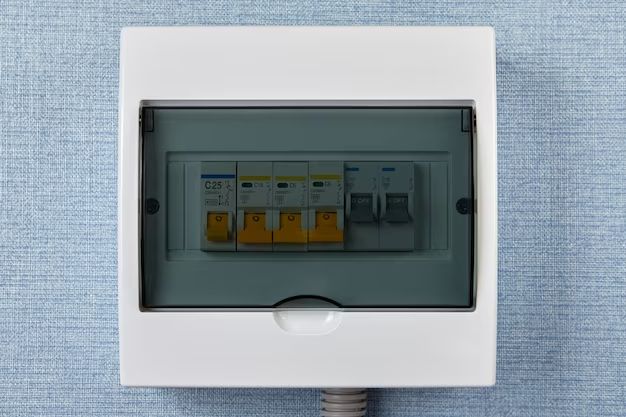Electrical breaker boxes, also known as panelboards or distribution boards, are necessary components of any home’s electrical system. However, they are often large metal boxes that can look quite unsightly, especially if located in visible areas of the home. There are several methods homeowners can use to conceal or obscure these eyesores and improve the aesthetics of a room.
Page Contents
Why Hide the Electrical Panel?
Some key reasons homeowners may want to hide their breaker box include:
- Improving the look of the room – Exposed breaker boxes can detract from the decor and style of a space.
- Increasing home value – A visibly appealing home can increase resale value.
- Safety concerns – Boxes protruding into walkways pose a tripping risk.
- Creating a seamless look – Hiding the panel helps spaces flow together smoothly.
Painting the Breaker Box
One of the simplest ways to help a breaker box blend in is to paint it. Painting the box the same color as the wall makes it less visually prominent. This is often the first step taken when fully concealing the box.
Process
- Clean the box thoroughly and lightly sand to prepare the surface for painting.
- Apply 1-2 coats of metal primer to the box and cover.
- Paint the box with 1-2 finish coats of latex or oil-based paint in the desired color.
- Avoid spraying paint directly at the box to prevent overspray seeping inside.
- Use high quality exterior paint for increased durability.
Tips
- Use the same paint brand/color as walls for seamless blending.
- Add texture with sand paint additives to match knockdown walls.
- Hire an electrician if unsure about painting regulations.
- Avoid painting over labels, wire colors, writing inside box.
Wallpaper or Faux Finishes
Another way to help the panel blend into the wall is to apply wallpaper or faux finishes. This disguises the box while still allowing access.
Wallpaper
- Purchase wallpaper matching the room’s walls.
- Prep box as if painting – clean, sand, apply primer.
- Brush adhesive onto box and apply wallpaper pieces.
- Use razor to neatly trim edges.
- Seal edges and seams with clear caulk.
Faux Finishes
- Faux techniques like ragging, sponging, texture coats, or trompe l’oeil painting can disguise the box.
- Match the wall’s base coat color.
- Hire a faux painter if unfamiliar with techniques.
- Seal painted box with protective clear coat for durability.
Concealing Behind Cabinetry
Cabinetry, such as shelving or enclosed cabinets, offer an effective way to fully conceal the breaker box.
Tips for Cabinetry Concealment
- Check electrical code requirements for clearance space needed.
- Box must have minimum 30 inches clear space in front.
- Use removable panels or dropdown cabinets to maintain access.
- Ensure cabinet interior has fire retardant treatment.
- Add ventilation holes if enclosed on all sides.
Built-in Bookcases
- Box can be hidden behind false wall of shelving.
- Leave at least 30 inches clearance between shelving and box.
- Lighting inside cabinet helps visibility when accessing box.
- Install sturdy removable shelving for easy access.
Concealment Boxes and Covers
For quick concealment, enclosure boxes can be installed over the panel.
Breaker Box Covers
- Box covers are available in various sizes.
- Covers fasten directly over existing panel.
- Can be painted to match walls.
- Provide fast concealment option.
Concealment Boxes
- Enclose entire breaker box in a concealment box.
- Often made of durable plastic or metal.
- Easy installation around box.
- Budget-friendly solution.
Relocating the Breaker Box
If desired, the homeowner can choose to relocate the electrical panel to a more discreet location.
New Locations
- Basement
- Garage
- Closet
- Utility room
Considerations for Relocating
- An expensive option, $500-$2000 depending on home’s electrical system.
- Permits usually required for moving panel.
- Inspect new location to ensure adequate clearance space.
- An electrician must disconnect and reconnect all electrical wiring.
Working with Electrical Contractors
For any major concealment project, hiring a professional electrician is advised. They can:
- Ensure all electrical codes and standards are met.
- Provide expert advice on the feasibility of ideas.
- Manage required permits and inspections.
- Safely relocate wires and electrical infrastructure.
- Install cabinets and build surrounding structures.
Discuss your goals and constraints to determine the best option. Get contractor estimates before starting.
DIY Precautions with Breaker Boxes
Exercise extreme care when working around a live electrical panel yourself:
- Turn off main breaker switch before starting any work.
- Never touch wires or components inside the box.
- Avoid spraying cleaners or liquids near the interior.
- Do not block ventilation openings.
- Leave all covers and barriers in their original place.
Consult an electrician if unsure about the safety of any concealment method.
Key Takeaways
- Painting the breaker box the same color as walls offers a low-cost way to help it blend in.
- Wallpaper and faux finishing techniques can further disguise the box.
- Cabinetry like bookshelves or full cabinet fronts effectively conceal the panel.
- Relocating to a basement or closet hides the box but can be expensive.
- Hire a professional electrician for major electrical work.
Concealing an unattractive breaker box improves aesthetics and home value. With careful planning and safe electrical practices, the box can be discreetly hidden without sacrificing function.
